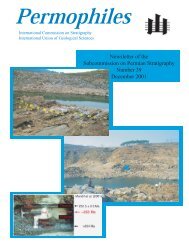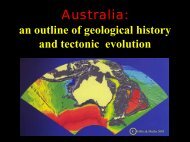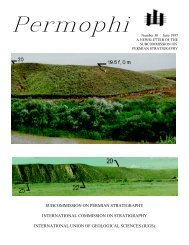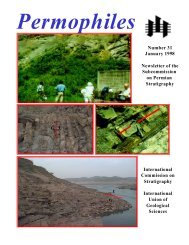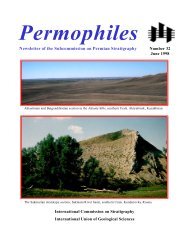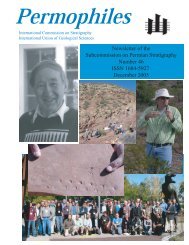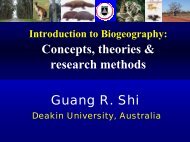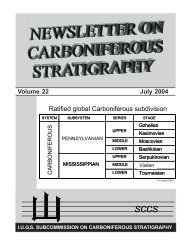Newsletter of the Subcommission on Permian Stratigraphy Number ...
Newsletter of the Subcommission on Permian Stratigraphy Number ...
Newsletter of the Subcommission on Permian Stratigraphy Number ...
Create successful ePaper yourself
Turn your PDF publications into a flip-book with our unique Google optimized e-Paper software.
oundary. Logan, A., Hills, L. V. (ed.) Canad. Soc. Petrol.<br />
Geol. Mem., vol.2, p. 572-595.<br />
Jin, Yu-gan, Menning, M. , 1996. A possible North-South correlati<strong>on</strong><br />
<str<strong>on</strong>g>of</str<strong>on</strong>g> <str<strong>on</strong>g>the</str<strong>on</strong>g> <strong>Permian</strong>. Permophiles, vol. 29, p. 40-41.<br />
Kotlyar, G. V., Nestell, G. P., Zhakarov, Y. D., Nestell, M. K., 1999.<br />
Changhsingian <str<strong>on</strong>g>of</str<strong>on</strong>g> <str<strong>on</strong>g>the</str<strong>on</strong>g> northwestern Caucasus, sou<str<strong>on</strong>g>the</str<strong>on</strong>g>rn<br />
Primoyre and sou<str<strong>on</strong>g>the</str<strong>on</strong>g>astern Pamirs. Permophiles, vol. 35, p.<br />
18-22.<br />
Kozur, H., 1998. The <strong>Permian</strong> c<strong>on</strong>od<strong>on</strong>t biochr<strong>on</strong>ology: Progress<br />
and Problems. Proc. Roy. Soc. Victoria, vol. 110, p. 197-220.<br />
Mei, Shi-l<strong>on</strong>g, Jin Yu-gan, Wardlaw, B. R., 1994. Successi<strong>on</strong> <str<strong>on</strong>g>of</str<strong>on</strong>g><br />
Wuchiapingian c<strong>on</strong>od<strong>on</strong>ts from nor<str<strong>on</strong>g>the</str<strong>on</strong>g>astern Sichuan and<br />
its worldwide correlati<strong>on</strong>. Acta Micropalae<strong>on</strong>t. Sinica, vol. 11<br />
(2), p. 121-139.<br />
Roberts, J., Claoue-L<strong>on</strong>g, J. C., Foster, C. B., 1996. SHRIMP zirc<strong>on</strong><br />
dating <str<strong>on</strong>g>of</str<strong>on</strong>g> <str<strong>on</strong>g>the</str<strong>on</strong>g> <strong>Permian</strong> System <str<strong>on</strong>g>of</str<strong>on</strong>g> eastern Australia. Aust. J.<br />
Earth Sci., vol. 43, p. 401-421.<br />
Ruzencev, V. E., Sarytcheva, T. G., 1965. The development and successi<strong>on</strong><br />
<str<strong>on</strong>g>of</str<strong>on</strong>g> marine organisms at <str<strong>on</strong>g>the</str<strong>on</strong>g> Paleozoic-Mesozoic boundary.<br />
Tr. Pale<strong>on</strong>t. Inst. , vol. 108 (in Russian).<br />
Shi, G. R., Waterhouse, J. B., 1996. Lower <strong>Permian</strong> brachiopods and<br />
Molluscs from <str<strong>on</strong>g>the</str<strong>on</strong>g> upper Jungle Creek Formati<strong>on</strong>, nor<str<strong>on</strong>g>the</str<strong>on</strong>g>rn<br />
Yuk<strong>on</strong> Territory. Can. Geol. Surv. Bull., vol. 424.<br />
Wardlaw, B. R. 1997. Tempo <str<strong>on</strong>g>of</str<strong>on</strong>g> c<strong>on</strong>od<strong>on</strong>t evoluti<strong>on</strong>, refined c<strong>on</strong>od<strong>on</strong>t<br />
biostratigraphy, and sequence stratigraphy <str<strong>on</strong>g>of</str<strong>on</strong>g> <str<strong>on</strong>g>the</str<strong>on</strong>g> <strong>Permian</strong><br />
with special emphasis <strong>on</strong> <str<strong>on</strong>g>the</str<strong>on</strong>g> Perig<strong>on</strong>dwana strata <str<strong>on</strong>g>of</str<strong>on</strong>g><br />
<str<strong>on</strong>g>the</str<strong>on</strong>g> Salt Range, Pakistan. Abstracts, The <strong>Permian</strong> <str<strong>on</strong>g>of</str<strong>on</strong>g> eastern<br />
Tethys: Biostratigraphy, Palaeogeography and Resources,<br />
p. 9. Rusden Campus, Deakin University, Melbourne.<br />
Wardlaw, B. R., Mei, S., 1999. Refined c<strong>on</strong>od<strong>on</strong>t biostratigraphy <str<strong>on</strong>g>of</str<strong>on</strong>g><br />
<str<strong>on</strong>g>the</str<strong>on</strong>g> <strong>Permian</strong> and lowest Triassic <str<strong>on</strong>g>of</str<strong>on</strong>g> <str<strong>on</strong>g>the</str<strong>on</strong>g> Salt and Khizor Ranges,<br />
Pakistan. In Yin, H. J., T<strong>on</strong>g, J. (ed.) Proc. Internat. C<strong>on</strong>f. <strong>on</strong><br />
Pangaea and <str<strong>on</strong>g>the</str<strong>on</strong>g> Palaeozoic-Mesozoic transiti<strong>on</strong>. Wuhan,<br />
China Univ. <str<strong>on</strong>g>of</str<strong>on</strong>g> Geoscience Press, p. 154-156.<br />
Waterhouse, J. B., 1981. Age <str<strong>on</strong>g>of</str<strong>on</strong>g> <str<strong>on</strong>g>the</str<strong>on</strong>g> Rat Buri Limest<strong>on</strong>e <str<strong>on</strong>g>of</str<strong>on</strong>g> sou<str<strong>on</strong>g>the</str<strong>on</strong>g>rn<br />
Thailand. Dep. Mineral. Res. Bangkok, Geol. Surv. Mem.,<br />
vol.4, p.1-42.<br />
Waterhouse, J. B., Piyasin, S., 1970. Mid-<strong>Permian</strong> brachiopods from<br />
Khao Phrik, Thailand. Palae<strong>on</strong>tographica A, vol. 135, p. 83-<br />
197.<br />
Zhou, Zuren, Glenister, B. F., Furnish, W. M., Spinosa, C., 1996.<br />
Multi-episodal extincti<strong>on</strong> and ecological differentiati<strong>on</strong> <str<strong>on</strong>g>of</str<strong>on</strong>g><br />
<strong>Permian</strong> amm<strong>on</strong>oids. Permophiles, vol. 29, p. 52-62.<br />
<strong>Permian</strong> Palaeogeography <str<strong>on</strong>g>of</str<strong>on</strong>g> <str<strong>on</strong>g>the</str<strong>on</strong>g> Tethyan Realm<br />
Ca<str<strong>on</strong>g>the</str<strong>on</strong>g>rine Jenny<br />
21 ch. de la Léchaire CH 1233 Lully, France<br />
Gérard Stampfli<br />
Institute <str<strong>on</strong>g>of</str<strong>on</strong>g> Geology, University <str<strong>on</strong>g>of</str<strong>on</strong>g> Lausanne, BFSH-2, CH-1015<br />
Lausanne, Switzerland<br />
http://www-sst.unil.ch/research/plate_tecto/members.htm<br />
Permophiles Issue #37 2000<br />
24<br />
The paleo-rec<strong>on</strong>structi<strong>on</strong>s<br />
There is still some c<strong>on</strong>fusi<strong>on</strong> about what Tethys existed at<br />
what time (e.g. Sengör 1985). A c<strong>on</strong>sensus exists, however, regarding<br />
<str<strong>on</strong>g>the</str<strong>on</strong>g> presence <str<strong>on</strong>g>of</str<strong>on</strong>g> a mainly Paleozoic ocean north <str<strong>on</strong>g>of</str<strong>on</strong>g> <str<strong>on</strong>g>the</str<strong>on</strong>g><br />
Cimmerian c<strong>on</strong>tinent(s) - <str<strong>on</strong>g>the</str<strong>on</strong>g> Paleotethys, a younger Late Paleozoic-Mesozoic<br />
ocean located south <str<strong>on</strong>g>of</str<strong>on</strong>g> this c<strong>on</strong>tinent - <str<strong>on</strong>g>the</str<strong>on</strong>g><br />
Neotethys, and finally a Middle Jurassic ocean - <str<strong>on</strong>g>the</str<strong>on</strong>g> Alpine Tethys<br />
(Favre & Stampfli 1992; Stampfli & Marchant 1997), an extensi<strong>on</strong><br />
<str<strong>on</strong>g>of</str<strong>on</strong>g> <str<strong>on</strong>g>the</str<strong>on</strong>g> Central Atlantic, which broke through <str<strong>on</strong>g>the</str<strong>on</strong>g> Pangea superc<strong>on</strong>tinent.<br />
These three oceanic realms form <str<strong>on</strong>g>the</str<strong>on</strong>g> Tethyan domain<br />
s.l. extending from Morocco to <str<strong>on</strong>g>the</str<strong>on</strong>g> Far-East (Sengör and Hsü 1984).<br />
The first geodynamically correct definiti<strong>on</strong> <str<strong>on</strong>g>of</str<strong>on</strong>g> <str<strong>on</strong>g>the</str<strong>on</strong>g> main Tethyan<br />
oceans, based <strong>on</strong> extensive fieldwork in <str<strong>on</strong>g>the</str<strong>on</strong>g> Middle East, was given<br />
by Stöcklin (1974) who recognized a Late Paleozoic? to Triassic<br />
oceanic realm cutting through <str<strong>on</strong>g>the</str<strong>on</strong>g> epi-Baikalian (Panafrican-<br />
G<strong>on</strong>dwanan) platform and separating <str<strong>on</strong>g>the</str<strong>on</strong>g> Iranian plate from Arabia,<br />
that he called Neotethys and ano<str<strong>on</strong>g>the</str<strong>on</strong>g>r older oceanic realm separating<br />
<str<strong>on</strong>g>the</str<strong>on</strong>g> Iranian epi-Baikalian (Panafrican) domain from <str<strong>on</strong>g>the</str<strong>on</strong>g> Variscan<br />
Turan domain to <str<strong>on</strong>g>the</str<strong>on</strong>g> north that he called Paleotethys (Stöcklin<br />
1969,1974, 1977, 1981).<br />
Following this proposal, we started an investigati<strong>on</strong> <str<strong>on</strong>g>of</str<strong>on</strong>g> <str<strong>on</strong>g>the</str<strong>on</strong>g><br />
eastern Alborz range (Stampfli 1978) and effectively defined it as a<br />
potential sou<str<strong>on</strong>g>the</str<strong>on</strong>g>rn margin <str<strong>on</strong>g>of</str<strong>on</strong>g> Stöcklin’s Paleotethys Ocean. The<br />
opening <str<strong>on</strong>g>of</str<strong>on</strong>g> this Paleozoic ocean was placed in Silurian time. At <str<strong>on</strong>g>the</str<strong>on</strong>g><br />
same time <str<strong>on</strong>g>the</str<strong>on</strong>g> ophiolites <str<strong>on</strong>g>of</str<strong>on</strong>g> Mashhad were recognised as most<br />
likely pertaining to <str<strong>on</strong>g>the</str<strong>on</strong>g> Paleotethys suture (see <str<strong>on</strong>g>the</str<strong>on</strong>g> review <str<strong>on</strong>g>of</str<strong>on</strong>g> Ruttner<br />
1993, c<strong>on</strong>cerning <str<strong>on</strong>g>the</str<strong>on</strong>g>se ophiolites).<br />
The drifting <str<strong>on</strong>g>of</str<strong>on</strong>g> <str<strong>on</strong>g>the</str<strong>on</strong>g> Irano-Afghan block from G<strong>on</strong>dwana to<br />
Laurasia was <str<strong>on</strong>g>the</str<strong>on</strong>g>n clearly recognised and c<strong>on</strong>strained by <str<strong>on</strong>g>the</str<strong>on</strong>g> evoluti<strong>on</strong><br />
<str<strong>on</strong>g>of</str<strong>on</strong>g> <str<strong>on</strong>g>the</str<strong>on</strong>g> micr<str<strong>on</strong>g>of</str<strong>on</strong>g>lora <str<strong>on</strong>g>of</str<strong>on</strong>g> <str<strong>on</strong>g>the</str<strong>on</strong>g> Iranian block from a G<strong>on</strong>dwanan<br />
affinity in Carb<strong>on</strong>iferous time (Coquel et al. 1977; Chateauneuf<br />
and Stampfli 1979) to an Eurasian affinity in Late Triassic time<br />
(Corsin and Stampfli 1977). The Eocimmerian orogeny was also<br />
defined in Iran at that time as a result <str<strong>on</strong>g>of</str<strong>on</strong>g> <str<strong>on</strong>g>the</str<strong>on</strong>g> closing Paleotethys<br />
and Middle Triassic collisi<strong>on</strong> <str<strong>on</strong>g>of</str<strong>on</strong>g> <str<strong>on</strong>g>the</str<strong>on</strong>g> Iranian block with <str<strong>on</strong>g>the</str<strong>on</strong>g> Eurasian<br />
Turan block (Stampfli 1978).<br />
This c<strong>on</strong>cept was later <strong>on</strong> extended fur<str<strong>on</strong>g>the</str<strong>on</strong>g>r west (Turkey) and<br />
East (Tibet, Far-east) by Sengör who defined <str<strong>on</strong>g>the</str<strong>on</strong>g> Cimmerian block<br />
as a ribb<strong>on</strong>-like micro-c<strong>on</strong>tinent separating Neotethys from<br />
Paleotethys (Sengör 1979; Sengör 1984; Sengör & Hsü 1984), he<br />
also defined at <str<strong>on</strong>g>the</str<strong>on</strong>g> same time <str<strong>on</strong>g>the</str<strong>on</strong>g> Cimmerian deformati<strong>on</strong> as n<strong>on</strong>-<br />
Hercynian or post Hercynian.<br />
New rec<strong>on</strong>structi<strong>on</strong> models were derived recently in order to<br />
reassess new plate tect<strong>on</strong>ic c<strong>on</strong>cepts developed in <str<strong>on</strong>g>the</str<strong>on</strong>g> Tethyan<br />
realm, based mainly <strong>on</strong> <str<strong>on</strong>g>the</str<strong>on</strong>g> review <str<strong>on</strong>g>of</str<strong>on</strong>g> <str<strong>on</strong>g>the</str<strong>on</strong>g> subsidence patterns <str<strong>on</strong>g>of</str<strong>on</strong>g><br />
<str<strong>on</strong>g>the</str<strong>on</strong>g> involved plate margins (Stampfli, 1996, 2000; Stampfli et al.<br />
1991, 1998 and In press; Stampfli & Pillevuit 1993; Stampfli &<br />
Marchant 1997; Stampfli & Mosar 1999). They are presented <strong>on</strong><br />
figure 1.<br />
The distributi<strong>on</strong> <str<strong>on</strong>g>of</str<strong>on</strong>g> <strong>Permian</strong> foraminifers<br />
Marine <strong>Permian</strong> biostratigraphic scales are based <strong>on</strong> several<br />
different organisms: amm<strong>on</strong>oids, foraminifers, and c<strong>on</strong>od<strong>on</strong>ts...<br />
This work c<strong>on</strong>siders <strong>on</strong>ly benthic foraminifers and calcareous<br />
algae. Normally, <str<strong>on</strong>g>the</str<strong>on</strong>g> more important benthic foraminifers are<br />
fusulinids. Never<str<strong>on</strong>g>the</str<strong>on</strong>g>less individuals <str<strong>on</strong>g>of</str<strong>on</strong>g> this group <str<strong>on</strong>g>of</str<strong>on</strong>g> organisms<br />
are in some areas missing or rare. Sometimes <str<strong>on</strong>g>the</str<strong>on</strong>g> index taxa have<br />
not been found in <str<strong>on</strong>g>the</str<strong>on</strong>g> deposits, <str<strong>on</strong>g>the</str<strong>on</strong>g>n we must use o<str<strong>on</strong>g>the</str<strong>on</strong>g>r foraminifers<br />
like nodosarids, genus <str<strong>on</strong>g>of</str<strong>on</strong>g> Biseriammindae, Hemigordiopsidae



